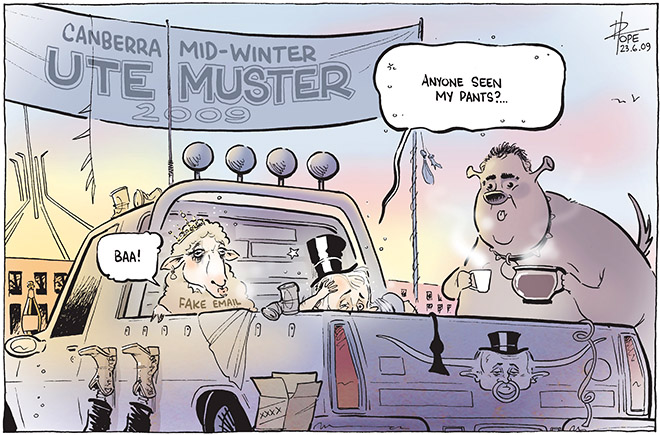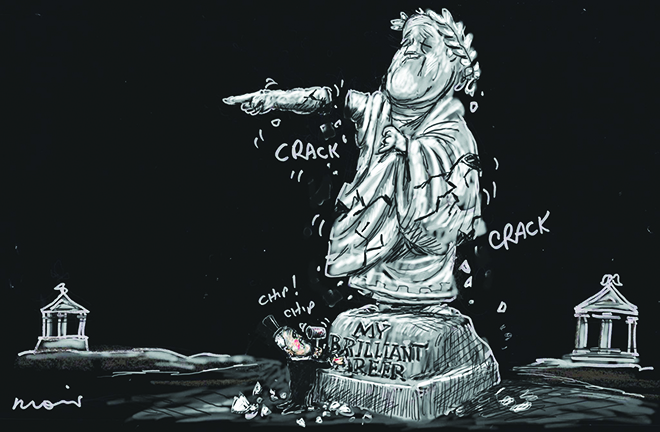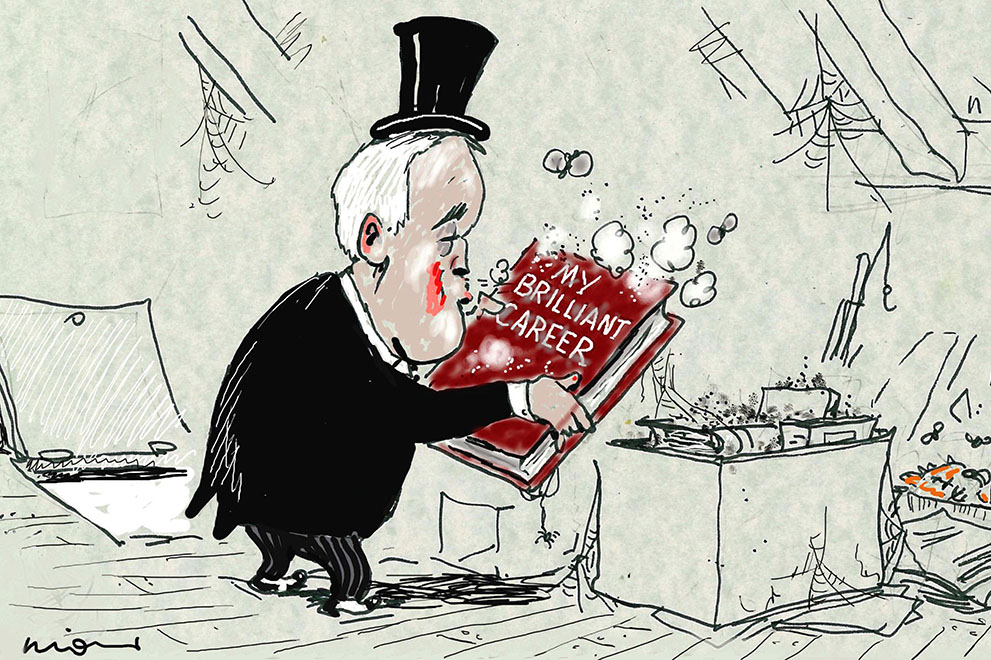My Brilliant Career: Malcolm Turnbull: A Political Life, in Cartoons
Edited by Russ Radcliffe | Scribe | $24.99
Our current prime minister (I write on 2 June, in the third millennium of the election campaign) is the subject of two unauthorised biographies, one of them by the redoubtable and entertaining Annabel Crabb. Now that we have Russ Radcliffe’s volume, however, I don’t know why anyone interested in Turnbull’s public life would bother with thousands of words of continuous prose. This brilliant combination of cartoons and quotations (from Turnbull himself, and from other public figures) gives us direct and incisive access to the Sturm und Drang of the Turnbull career. If you have a fair grasp of the plot, this is much more fun than the log cabin to White House fable, not least because in this case it’s from (a flat in) Wentworth to (a harbourside mansion in) Wentworth anyway. Quoting Alice in Wonderland against Crabb feels wrong on so many levels, but, given a choice, “What is the use of a book, without pictures or conversation?”
Russ Radcliffe has been doing political cartoon collections for over a decade, and he has finally cracked the problem of providing enough context for images no longer current without laboriously explaining the joke. This is the Lasseter’s Reef of cartoon commentary. Turnbull has left many well-turned sentences on the record since he conquered journalism in the 1970s, and Radcliffe has taken quite a few of them down to use in evidence for and against him. Add a few quotations from rivals and (curiously a smaller group) supporters, and you have a nice set of ironies to contextualise the cartoons in. And the cartoons, as ever, take you to the heart of the matter. Remember the brain snap from 2009 known as the Grech affair?

David Pope in the Canberra Times, 2009
Now you do. What was he thinking?
The cartoon history of Turnbull starts with the republic debate in the late 1990s, his first great crash after a seemingly inexorable rise to national prominence. His power as chief republican seemed personal and charismatic, attached to a cause rather than to a party or interest groups. Then he made the mistake of underestimating John Howard’s cunning; many have died on that hill.
The cartoonists have shown a wonderfully ruthless eye for both his habit of occasional self-immolation and his amazing powers of resurrection. The final cartoon in the volume, from one of the earlier aeons in this eternal election campaign, is by the great Alan Moir. It is a hope, a fear, and a prediction:

Alan Moir in the Sydney Morning Herald, 2016
When since Whitlam have we had such a combustible combination of grandeur and flakiness? As the pedestal beneath the collapsed statue of Ozymandias in Shelley’s poem says, “Look on my works, ye Mighty, and despair!”
So, buy this book. It tells the story of our times and our volunteer messiah brilliantly and economically. That’s what we have come to expect of our political cartoonists, even as the newspapers that support them sink and hide the cartoons in isolated galleries a dozen clicks behind the front page of their websites.
Now for the complaint, and it’s more about the cartoonists than the book. Even after two decades in the public eye, there is no abiding cartoon image of Turnbull. No Howard lip, no Easter Island Fraser; does anyone remember anything about Billy McMahon apart from his ears? All we have yet for Turnbull is that hat, even in the very good cartoons reprinted above.
My problem with the top hat is that Turnbull never wears one. Indeed, he almost never wears a hat at all. Type “Malcolm Turnbull hat” into Google images and you get a straw hat he wore once, a yellow floppy hat he wore when he was kayaking on the harbour, and an Akubra that proves he has once visited a Nationals seat. The top hat is really just lazy cartoonist shorthand for toff, and even toff is not a direct hit, because he wasn’t born to all that much money. I’ve been researching cartoons since the 1996 election campaign. I’ve seen them murder Keating, Howard, Rudd, Gillard and Abbott in turn. Even attendant lords with an amusing gimmick like Downer and Cormann have done better in the caricature stakes. The bestiary of Barnaby is already a large and varied freak show.
There seems to be something Teflon-coated about Turnbull that resists caricature, certainly compared to the hairy and lycra-clad Abbott. He always looks a little dapper in cartoons, as in life. For a while in late 2015, I thought this may be because the cartoonists shared the widespread desire to see in him a change from the fractious and often infantile politics of the past decade. Even if that is so, the grace period should be over now that the new prime minister has made at least his share of errors and equivocations. It’s time for someone to “own” Turnbull in the same way Ron Tandberg could call up all the moods of Malcolm Fraser in half a dozen spare lines.
This collection tells the story of Turnbull’s stuttering rise to power with wit and economy. But it also shows that no cartoonist has yet found the core of ridiculousness in Turnbull, or of extremity. He is shorter and pudgier than George Clooney, but he “looks the part” nearly as well as him. No persistent metaphor of absurdity has entered the public mind.
But there is still time. •




